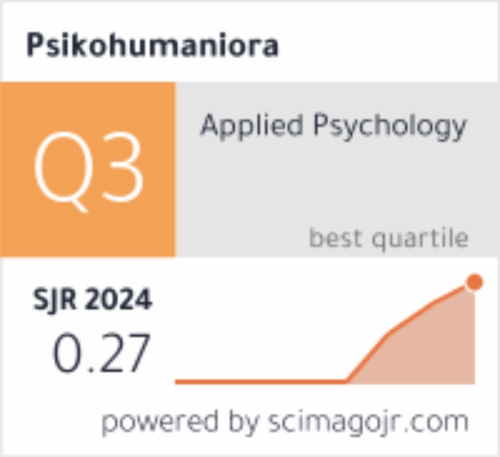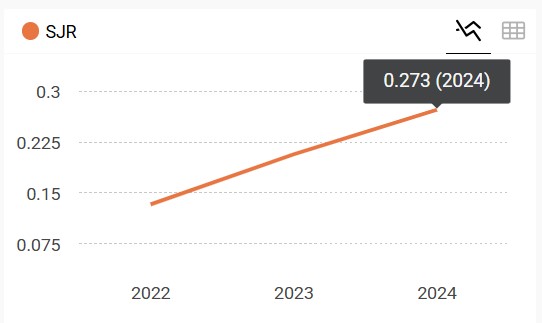Kerendahhatian dan Pemaafan pada Mahasiswa
DOI:
https://doi.org/10.21580/pjpp.v1i1.963Keywords:
forgiveness, humility, studentsAbstract
Abstract: This study aims to determine the correlation between humility and forgiveness in students. Respondents in this research are 252 students majoring in Psychology, Faculty of Psychology and Social and Cultural Sciences, Islamic University of Indonesia, with ages range from 17 to 24 years old. The hypothesis put forward by researchers is that there is positive correlation between the variables of humility and forgiveness in students. The research data in this study were analyzed using analytical techniques and product moment correlation from Karl Pearson; that is used to examine the relation between variables. The results showed that there is a positive correlation between humility and forgiveness (r = 0. 508 and p <0. 05) with the contribution of humility on the forgiveness of 25. 8%. Other results showed that there are different aspects of humility that contribute to forgiveness, in terms of demographic variables of age and gender.
Abstrak: Penelitian ini bertujuan untuk mengetahui hubungan kerendahhatian dan pemaafan pada mahasiswa. Responden dalam penelitian ini adalah 252 mahasiswa jurusan psikologi, Fakultas Psikologi dan Ilmu Sosial Budaya Universitas Islam Indonesia, dengan rentang usia 17-24 tahun. Hipotesis yang diajukan peneliti adalah adanya hubungan positif antara variabel kerendahhatian dan pemaafan pada mahasiswa. Data yang diperoleh dalam penelitian dianalisis dengan menggunakan teknik analisis dan korelasi product moment dari Karl Pearson yang digunakan untuk melihat hubungan antar variabel. Hasil penelitian menunjukkan bahwa ada korelasi positif antara kerendahhatian dan pemaafan(r= 0, 508 dan p<0, 05) dengan kontribusi variabel kerendahhatian pada pemaafan sebesar 25, 8%. Hasil lainnya menunjukkan ada perbedaan aspek kerendahhatian yang berkontribusi pada pemaafan ditinjau dari variabel demografi usia dan jenis kelamin.
Downloads
References
Arif, T. A. (2013). Komitmen dengan Pemaafan dalam hubungan persahabatan. Jurnal Online Psikologi, 1(2). Retrieved from http://ejournal. umm. ac. id/index. php/jop/ article/ view/1648
Ashton, M. C., & Lee, K. (2007). Empirical, theoretical, and practical advantages of the HEXACO model of personality structure. Personality and Social Psychology Review, 11(2), 150–166.
Brosschot, J. F., & Thayer, J. F. (2003). Heart rate response is longer after negative emotions than after positive emotions. International Journal of Psychophysiology, 50(3), 181–187. https://doi. org/10. 1016/S0167-8760(03)00146-6
Burney, D. M., & Kromrey, J. (2001). Initial development and score validation of the adolescent anger rating scale. Educational and Psychological Measurement, 61(3), 446–460.
Çardak, M. (2013). The relationship between forgiveness and humility: A case study for university students - ProQuest. Educational Research and Reviews, 8(8), 425.
Cohen, S., Mermelstein, R., Kamarck, T., & Hoberman, H. M. (1985). Measuring the functional components of social support, 73–94. https://doi. org/10. 1007/978-94-009-5115-0_5
Depkes, R. I. (2009). Profil kesehatan Indonesia. Jakarta: Depkes RI.
Elliott, J. C. (2010). Humility: Development and analysis of a scale. University of Tennessee, Knoxville. Retrieved from http://trace. tennessee. edu/utk_graddiss/795
Enright, R. D. (2001). Forgiveness is a choice. Washington DC: American Psychological Association.
Fincham, F. D., Beach, S. R. H., & Davila, J. (2004). Forgiveness and conflict resolution in marriage. Journal of Family Psychology, 18(1), 72–81. https://doi. org/10. 1037/0893-3200. 18. 1. 72
Gani, H. A. (2011). Forgiveness therapy. Yogyakarta: Kanisius Yogyakarta.
Ghuzairoh, T. (2015). Perbedaan forgiveness ditinjau dari jenis kelamin pada Budaya Jawa. Fakultas Psikologi UIN Sunan Maulana Malik Ibrahim Malang.
Glynn, L. M., Christenfeld, N., & Gerin, W. (2002). The role of rumination in recovery from reactivity: Cardiovascular consequences of emotional states. Psychosomatic Medicine, 64(5), 714–726.
Jie, W., Tingting, M., Shijin, S., Lulu, Y., & Feng, W. (2011). Higher ruminative tendency of anger in trust-forgiveness young adults. Singapore: IACSIT Press.
Khalid, A. (2006). Semua akhlak nabi. Solo: Aqwam.
McCullough, M. E., Rachal, K. C., Sandage, S. J., Worthington, E. L., Jr., Brown, S. W., & Hight, T. L. (1998). Interpersonal forgiving in close relationships: II. Theoretical elaboration and measurement. Journal of Personality and Social Psychology, 75(6), 1586–1603. https://doi. org/10. 1037/0022-3514. 75. 6. 1586
Nashori, F. (2012). Pemaafan pada Etnis Jawa. Unpad, Bandung.
Nashori, F. (2014). Psikologi pemaafan. Yogyakarta: Safiria Insania Press.
Nashori, F., Iskandar, T. Z., Setiono, K., & Siswandi, A. G. P. (2011). Tema-tema pemaafan pada mahasiswa Yogyakarta. Yogyakarta: Fakultas Psikologi dan Ilmu Sosial Budaya UII.
Nashori, F., & Wijaya, H. E. (2015). Pemaafan pada Etnis Minangkabau (Pengaruh religiositas dan keterikatan interpersonal melalui sifat kebersetujuan dan sifat neurotisisme terhadap pemaafan). Yogyakarta: Fakultas Psikologi dan Ilmu Sosial Budaya UII.
Rostiana. (1999). Diskripsi dan dinamika koflik pada boundary role person. Jurnal Ilmiah Arkhe, 4 (7).
Santrock, J. W. (2002a). Life span–development Edisi Kelima Jilid 2 (5th ed. ). Jakarta: Erlangga.
Smith, T. W. (1992). Hostility and health: Current status of a psychosomatic hypothesis. Health Psychology, 11(3), 139–150. https://doi. org/10. 1037/0278-6133. 11. 3. 139
Snyder, C. R., & Heinze, L. S. (2005). Forgiveness as a mediator of the relationship between PTSD and hostility in survivors of childhood abuse. Cognition & Emotion, 19(3), 413–431. https://doi. org/10. 1080/02699930441000175
Syamil Quran. (2009). al-Qur’an dan terjemahan. Bandung: Sygma.
Templeton, J. M. (1997). Worldwide laws of life: Two hundred eternal spiritual principles. Tice: Templeton Press.
Thayer, J. F., & Lane, R. D. (2000). A model of neurovisceral integration in emotion regulation and dysregulation. Journal of Affective Disorders, 61(3), 201–216. https://doi. org/10. 1016/S0165-0327(00)00338-4
Worthington, E. L., & Scherer, M. (2004). Forgiveness is an emotion-focused coping strategy that can reduce health risks and promote health resilience: theory, review, and hypotheses. Psychology & Health, 19(3), 385–405. https://doi. org/10. 1080/ 0887044042000196674
Worthington, E. L., Witvliet, C. V. O., Pietrini, P., & Miller, A. J. (2007). Forgiveness, health, and well-being: A review of evidence for emotional versus decisional forgiveness, dispositional forgivingness, and reduced unforgiveness. Journal of Behavioral Medicine, 30(4), 291–302. https://doi. org/10. 1007/s10865-007-9105-8
http://www.merdeka.com/peristiwa/ini-motif-pembunuhan-ade-sara-oleh-sepasang-kekasih. htm. (diakeses pada 07 Maret 2015).
Downloads
Published
How to Cite
Issue
Section
License
The copyright of the accepted article shall be assigned to the publisher of the journal. The intended copyright includes the right to publish the article in various forms (including reprints). The journal maintains the publishing rights to published articles.
In line with the license, authors and any users (readers and other researchers) are allowed to share and adapt the material only for non-commercial purposes. In addition, the material must be given appropriate credit, provided with a link to the license, and indicated if changes were made. If authors remix, transform, or build upon the material, authors must distribute their contributions under the same license as the original.




